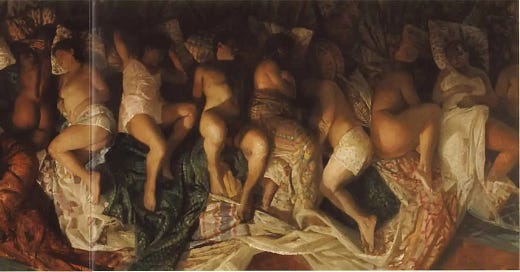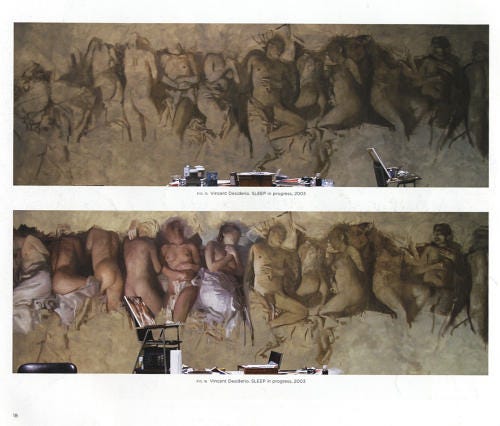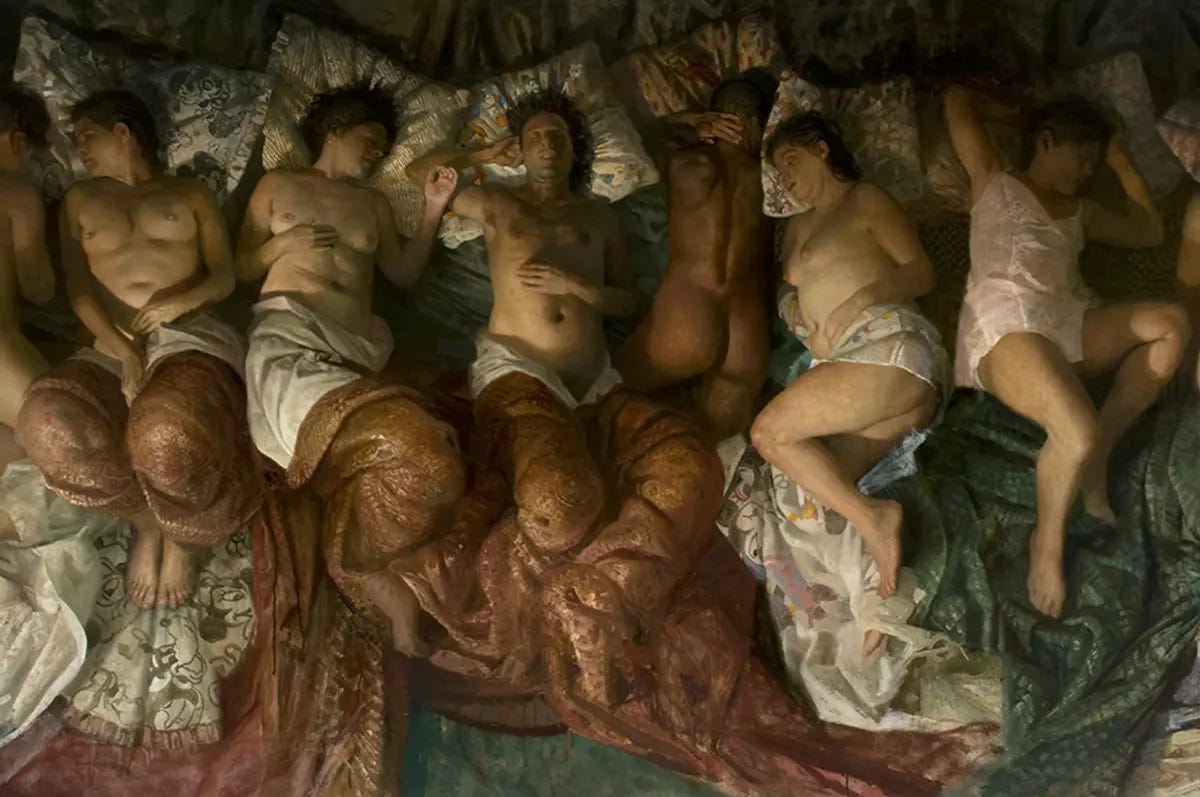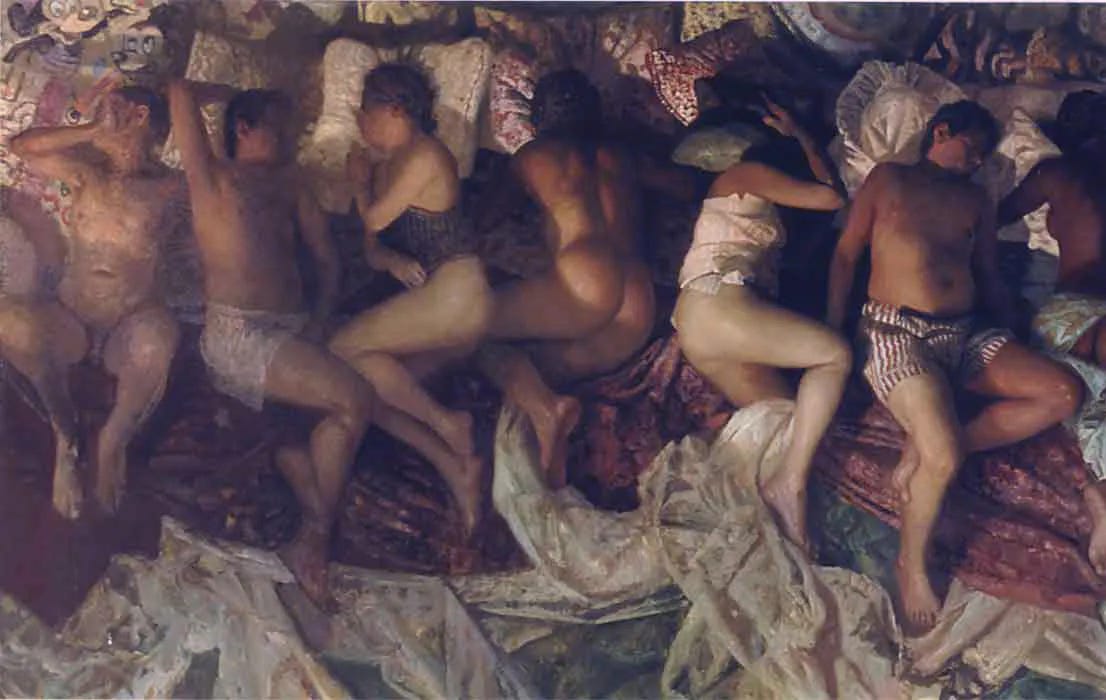Wake Me When It’s Over
I am the sleeping soul, bored of wokeness, dreaming of connection, meaning, and truth, waiting for the revival to begin
Wake me when the tide turns, when the great awakening begins—not one driven by ideologies or social engineering, but by a deeper understanding of what it means to be human. Call on me when we remember that beneath the blankets of identity, politics, and performance, there is something more profound: the sleeping soul, dreaming of connection, meaning, and truth.
Wake me when diversity politics have gotten sufficiently diverse as to finally be about individuals and ideas, not just the prepackaged groups into which we’ve all been slotted, sorted, and intersected.
Call on me when we stop pretending that ticking boxes of race, gender, and sexuality can substitute for recognizing the unique fragility of each human being—their creative thoughts, their contributions, and their character.
Wake me when equality returns to its original meaning: being treated as peers in the public realm, where each person is judged by their abilities and contributions, not their membership in a designated category. The shift toward equity—obsessed with equal outcomes for groups—undermines the very foundations of individual responsibility and shared human dignity.
Wake me when diversity means encouraging free discussion, rather than suppressing it in rigid, performative ways. When we stop bureaucracies from using identity politics as mechanisms of control—enforcing ideological orthodoxy on compliant workers in place of fostering true understanding and freedom.
Wake me when the banks stop peddling slogans about diversity and inclusion not because they believe in the inherent dignity of the individual, but because it looks good in an email, boosts their bottom line, or keeps them safe from backlash. When the genuine pursuit of justice is no longer reduced to a marketing tool, and corporate boardrooms stop mistaking dehumanizing tokenism for defiant transformation.
It’s hard to take seriously a movement for equity when its loudest champions are multinational conglomerates using identity politics to sell sneakers and soft drinks.
You could describe it as the institutionalizing of human decency—a process where what was once an organic, deeply felt human value becomes bureaucratized, standardized, and ultimately drained of its original meaning. In the context of Desiderio’s Sleep, this idea aligns with how modern society’s approach to diversity and identity has shifted. What should be a natural respect for individual dignity and decency has been reduced to counting rigid categories, checklists, and performative gestures that attempt to institutionalize what should come from a place of genuine empathy and understanding.
The trick of Desiderio’s Sleep lies in how it subtly exposes the modern viewer’s conditioned impulse to categorize and sort. Many viewers, upon seeing the painting, are almost instinctively drawn to count, classify, and search for markers of race, gender, or identity—methods we’ve been indoctrinated to prioritize above all else. But Sleep resists this impulse. Its figures blend in shades and forms that refuse easy categorization, leaving the viewer grasping for distinctions that simply aren’t there. In doing so, the painting quietly critiques the modern lens through which we are trained to see the world—one that seeks division, separation, and labels where there might only be unity, ambiguity, and shared humanity.
Vincent Desiderio’s long unfinished Sleep is often interpreted as a reflection on the collective unconscious, dreams, and the shared experience of human vulnerability. The painting depicts a series of people lying side by side in various states of sleep, evoking a sense of intimacy and connection, yet also isolation. The figures, though together, are in their own private dream worlds, unaware of each other, which speaks to the perpetual paradox of human existence—our simultaneous proximity and separation.
Desiderio himself has suggested that Sleep is about the tension between wakefulness and unconsciousness, the space between life and dreams, and how we, as humans, drift on a continuum of awareness. He has talked about how the painting symbolizes the human condition—an ambiguous zone where the personal and the universal intersect. The figures, all different yet equally vulnerable in their slumber, can be seen as a metaphor for society’s collective state of inertia or passivity, waiting for something to stir them awake.
In essence, Sleep explores the fragility of human consciousness and existence, how we are bound by our shared humanity yet locked in our individual experiences. It touches on themes of oblivion, vulnerability, and the desire to be awakened to a deeper, more profound reality.
The figures in the painting are depicted in varying shades, hues, and forms, but without clear markers of race, gender, or other identity categories that dominate modern discourse. The trick of the painting is how many viewers today on seeing it begin to count and categorize and sort by the methods we’re indoctrinated into seeing above all other features and cues. In the realism of the painting, they are simply human—vulnerable, unconscious, and at rest. In this state of sleep, individuality transcends the superficial boundaries of identity politics, and the idea of sorting people into predefined boxes becomes irrelevant.
The painting shows that, at the most fundamental level, we are united by our shared human experience rather than divided by the external traits that identity politics often emphasizes. By rendering the characters in an ambiguous and interconnected form, Sleep highlights the absurdity of reducing human beings to labels and categories. It invites the viewer to see beyond those constructs, recognizing the universality of human existence—our dreams, fears, and vulnerabilities—that transcends the visible and political markers we often use to define one another.
Wake me when corporations realize that slapping a rainbow flag or a 'DEI-certified' badge on their brand and useless plastic products doesn’t absolve them from exploiting workers, dodging taxes, or creating a culture of consumerism that thrives on the very divisions they claim to heal. When the conversation shifts from empty gestures to real, difficult work—the kind that doesn’t fit neatly into a hashtag, a quarterly earnings report, or a GDP number.
Wake me when the entertainment industry remembers that its power lies in storytelling, not sermonizing. Wake me when the stories we tell are no longer reduced to blunt instruments of moral instruction, designed to shame rather than inspire. We’ve lost the magic of storytelling—the kind that stirs the imagination, makes us question, laugh, and cry—by turning every plotline into a teachable moment. Audiences crave escape, empathy, and catharsis, not endless lectures about systems and structures. The industry has confused education with art, forgetting that people tune in for stories that lift them up, not for reminders of what drags them down.
Wake me when the creators remember that the audience is not the enemy to be corrected but a partner in a shared journey—when entertainment becomes a space for exploration, not indoctrination. Stories are meant to reveal the human condition, not preach it. Only then will we recover the true essence of why we tell stories in the first place.
Wake me when the church remembers what it was built for: tending to the soul, not preaching the latest social dogma. Call on me when the pews are filled with people seeking fellowship, forgiveness, and spiritual growth—not just slogans about equity and climate action that could just as easily be found in the corporate training manual. The church was once a sanctuary, a place to wrestle with the eternal, the mysterious, the sacred. Now it has become a pulpit for the same tired, secular sermons we hear everywhere else—stripped of wonder, of virtue as its own reward, of treating others well because it’s right, not because it’s trending.
Wake me when the church reclaims its mission to care for souls, not align itself with passing political fashions or virtue-signaling causes. When the sermons return to humility, grace, and compassion, not endless scolding about privilege or carbon footprints. The church, at its best, is a place to remind us that we're flawed but capable of redemption—not another venue for finger-pointing and ideological purity tests for the forever damned.
Ideologies thrive in times of crisis and dispair, offering false certainties in the face of infinite human complexity. We were told that diversity would enrich our society. Instead, it's been reduced to a series of numbers and quotas, of management mandates reported by the CBC, and the individual is once again lost—this time, not to the mob, but to the bureaucrat’s spreadsheet.
Wake me when we remember that the real power of politics lies in plurality: the meeting of distinct individuals, each with a story to tell, a mind to engage, and a life to live.
Wake me when the revival begins—when we reclaim our capacity for wonder, debate, and real connection. And when it does, I’ll be wide awake, ready to help rebuild what we lost along the way.
Writer’s Note: As a TV producer, I work on the front lines of an industry where identity politics is not just an idea, but a deeply entrenched system. Every decision, every pitch, every conversation seems to revolve around checking the right boxes and fitting into prescribed narratives. I can’t remember the last time I had a conversation about entertainment, story, or delivering something fun to an audience.
I may come across as a little shrill in what I’ve written, but that’s because I’ve seen the effects of divisive diversity up close—in its most bureaucratic, systematized form. The push for inclusivity, while well-intentioned, has too often turned into a rigid exercise in conformity, where individual stories and audiences are overshadowed by identity quotas and performative gestures. I’m writing this as someone who believes in the power of true diversity, but also someone who has grown weary of how it’s been institutionalized to the point where it divides more than it unites.
jw









Okay. I can get behind this, pretty much all of it. Still not sure "woke" should ever be a noun though.
The spirit of the thought is correct. It's the implementation that I think is trickier than you imagine and perhaps has more consequences than you've thought of. I've been thinking through that for awhile now too.
First, it's going to require less virtue signalling and some really tough discussions be had out in the open. Here's a huge challenge for you, I hesitated even to bring up in this venue because it's just the sort of thorny, sticky, gross issue that needs to be tackled but it's also all those things and we don't talk about them in polite society. That would be the rape of Gisèle Pelicot.
Yeah, I know it's happening in France, not here, but the fact that more than 30 of her rapists still don't consider themselves rapists says something about the dark turn onto a dangerous road that masculinity and masculine privilege has sometimes taken. The fact that most of the people involved lived quiet, unexceptional lives before being exposed just means it's bound to be more pervasive than we realized or at least acknowledged. The inability to admit that whatever dark fantasies they had before the rapes should have remained wholly fictional in their minds is both a sad tragedy that our society can't allow the release of such tensions and the fact that somewhere the fault lines of society create and allow such tensions in the minds of men to flourish. Women too, don't kid yourself that their kinkiness is any less, but these men acted and the husband pimped her out. This kind of behaviour must change in order to strengthen the bonds between men and women and sexual minorities of all kinds (we used to be called "deviants" you know) but the truth needs to be out there and the forces of emasculation need to be examined alongside the forces of privilege. Balance can't be meaningfully achieved without very tough, very tragic and very fraught discussions like this. We simply haven't yet done that work or we wouldn't now be in this position.
Another issue would be the fact that two rapists currently sitting on the US Supreme Court were allowed to decide how women's bodies should be managed, without their consent of course. Spoiler, it didn't turn out well. Yeah, that's a US issue, but don't kid yourself that there are no rapists on the bench here or that Canadian gynaecological decisions are wholly the province of women. Or, most importantly, how control of a partner, rather than unconditional support (love) is part of calculus in all relationships in Canada. It goes both to unrealistic female expectations and roles and unrealistic male expectations and roles and the flawed models on both sides.
As I've said before, our national stories are somewhat fictional in order to cover more ground and be more palatable, but perhaps they've become overly fictional and are in need of some raw, unabridged and ugly, messy, unweildy truth.